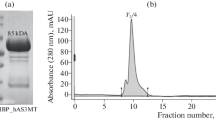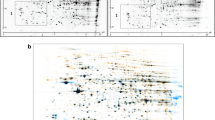Abstract
We previously developed a screening method to identify proteins that undergo aggregation through S-mercuration by methylmercury (MeHg) and found that rat arginase I is a target protein for MeHg (Kanda et al. in Arch Toxicol 82:803–808, 2008). In the present study, we characterized another S-mercurated protein from a rat hepatic preparation that has a subunit mass of 42 kDa, thereby facilitating its aggregation. Two-dimensional SDS–polyacrylamide gel electrophoresis and subsequent peptide mass fingerprinting using matrix-assisted laser desorption and ionization time-of-flight mass spectrometry revealed that the 42 kDa protein was NAD-dependent sorbitol dehydrogenase (SDH). With recombinant rat SDH, we found that MeHg is covalently bound to SDH through Cys44, Cys119, Cys129 and Cys164, resulting in the inhibition of its catalytic activity, release of zinc ions and facilitates protein aggregation. Mutation analysis indicated that Cys44, which ligates the active site zinc atom, and Cys129 play a crucial role in the MeHg-mediated aggregation of SDH. Pretreatment with the cofactor NAD, but not NADP or FAD, markedly prevented aggregation of SDH. Such a protective effect of NAD on the aggregation of SDH caused by MeHg is discussed.





Similar content being viewed by others
Notes
The C164S mutant failed to refold from the insoluble inclusion bodies expressed in E. coli.
Abbreviations
- MeHg:
-
Methylmercury
- API:
-
Achromobacter protease I
- SDH:
-
Sorbitol dehydrogenase
- GSH:
-
Glutathione
- MALDI-TOF/MS:
-
Matrix-assisted laser desorption/ionization time-of-flight mass spectrometry
- NEM:
-
N-ethylmaleimide
- 2-ME:
-
2-Mercaptoethanol
- MnCl2 :
-
Manganese chloride
- PVDF:
-
Polyvinylidene difluoride
- BPM:
-
Biotin-PEAC5-maleimide
- CBB:
-
Coomassie brilliant blue
References
Barcelos GR, Grotto D, Serpeloni JM, Angeli JP, Rocha BA, de Oliveira Souza VC, Vicentini JT, Emanuelli T, Bastos JK, Antunes LM, Knasmüller S, Barbosa F Jr (2011) Protective properties of quercetin against DNA damage and oxidative stress induced by methylmercury in rats. Arch Toxicol 85:1151–1157
Bradford MM (1976) A rapid and sensitive method for the quantitation of microgram quantities of protein utilizing the principle of protein-dye binding. Anal Biochem 72:248–254
Clarkson TW (1972) The pharmacology of mercury compounds. Annu Rev Pharmacol 12:375–406
Coccini T, Roda E, Castoldi AF, Poli D, Goldoni M, Vettori MV, Mutti A, Manzo L (2011) Developmental exposure to methylmercury and 2,2′,4,4′,5,5′-hexachlorobiphenyl (PCB153) affects cerebral dopamine D1-like and D2-like receptors of weanling and pubertal rats. Arch Toxicol 85:1281–1294
Hellgren M, Kaiser C, de Haij S, Norberg A, Höög JO (2007) A hydrogen-bonding network in mammalian sorbitol dehydrogenase stabilizes the tetrameric state and is essential for the catalytic power. Cell Mol Life Sci 64:3129–3138
Henzel WJ, Billeci TM, Stults JT, Wong SC, Grimley C, Watanabe C (1993) Identifying proteins from two-dimensional gels by molecular mass searching of peptide fragments in protein sequence databases. Proc Natl Acad Sci 90:5011–5015
Iwamatsu A, Yoshida-Kubomura N (1996) Systematic peptide fragmentation of polyvinylidene difluoride (PVDF)-immobilized proteins prior to microsequencing. J Biochem 120:29–34
Iwamoto N, Nishiyama A, Eiguren-Fernandez A, Hinds W, Kumagai Y, Froines JR, Cho AK, Shinyashiki M (2010) Biochemical and cellular effects of electrophiles present in ambient air samples. Atmos Environ 44:1483–1489
Jeffery J, Jörnvall H (1988) Sorbitol dehydrogenase. Adv Enzymol Relat Areas Mol Biol 61:47–106
Johansson K, El-Ahmad M, Kaiser C, Jörnvall H, Eklund H, Höög J, Ramaswamy S (2001) Crystal structure of sorbitol dehydrogenase. Chem Biol Interact 130–132:351–358
Kanda H, Sumi D, Endo A, Toyama T, Chen CL, Kikushima M, Kumagai Y (2008) Reduction of arginase I activity and manganese levels in the liver during exposure of rats to methylmercury: a possible mechanism. Arch Toxicol 82:803–808
Karlsson C, Jörnvall H, Höög JO (1991) Sorbitol dehydrogenase: cDNA coding for the rat enzyme. Variations within the alcohol dehydrogenase family independent of quaternary structure and metal content. Eur J Biochem 198:761–765
Kosower NS, Kosower EM (1978) The glutathione status of cells. Int Rev Cytol 54:109–160
Maret W, Auld DS (1988) Purification and characterization of human liver sorbitol dehydrogenase. Biochemistry 27:1622–1628
Miura T, Shinkai Y, Hirose R, Iwamoto N, Cho AK, Kumagai Y (2011) Glyceraldehyde-3-phosphate dehydrogenase as a quinone reductase in the suppression of 1,2-naphthoquinone protein adduct formation. Free Radic Biol Med 51:2082–2089
Nakamura M, Yasutake A, Fujimura M, Hachiya N, Marumoto M (2011) Effect of methylmercury administration on choroid plexus function in rats. Arch Toxicol 85:911–918
Rabenstein DL, Fairhurst MT (1975) Nuclear magnetic resonance studies of the solution chemistry of metal complexes. XI. The binding of methylmercury by sulfhydryl-containing amino acids and by glutathione. J Am Chem Soc 97:2086–2092
Rasband WS (1997) ImageJ. U.S. National Institutes of Health, Bethesda, Maryland, USA. http://imagej.nih.gov/ij/. Accessed 6 Oct 2006
Rodrigues JL, Serpeloni JM, Batista BL, Souza SS, Barbosa F Jr (2010) Identification and distribution of mercury species in rat tissues following administration of thimerosal or methylmercury. Arch Toxicol 84:891–896
Schimke RT (1970) Arginase (rat liver). Methods Enzymol 17A:313–317
Shinyashiki M, Kumagai Y, Homma-Takeda S, Nagafune J, Takasawa N, Suzuki J, Matsuzaki I, Satoh S, Sagai M, Shimojo N (1996) Selective inhibition of the mouse brain Mn-SOD by methylmercury. Environ Toxicol Pharmacol 2:359–366
Shinyashiki M, Kumagai Y, Nakajima H, Nagafune J, Homma-Takeda S, Sagai M, Shimojo N (1998) Differential changes in rat brain nitric oxide synthase in vivo and in vitro by methylmercury. Brain Res 798:147–155
Simpson RB (1961) Association constants of methylmercury with sulfhydryl and other bases. J Am Chem Soc 83:4711–4717
Wagner C, Vargas AP, Roos DH, Morel AF, Farina M, Nogueira CW, Aschner M, Rocha JB (2010) Comparative study of quercetin and its two glycoside derivatives quercitrin and rutin against methylmercury (MeHg)-induced ROS production in rat brain slices. Arch Toxicol 84:89–97
Yasutake A, Nakano A, Miyamoto K, Eto K (1997) Chronic effects of methylmercury in rats. I. Biochemical aspects. Tohoku J Exp Med 182:185–196
Zou HC, Lü ZR, Wang YJ, Zhang YM, Zou F, Park YD (2009) Effect of cysteine modification on creatine kinase aggregation. Appl Biochem Biotechnol 152:15–28
Acknowledgments
We thank Dr. Daigo Sumi (Faculty of Pharmaceutical Sciences, Tokushima Bunri University) and Dr. Akira Yasutake (National Institute for Minamata Disease) for helpful advice; Dr. Nobuhiro Shimojo (University of Tsukuba) for his encouragement; Drs. Tomomi Gotoh and Masataka Mori (Department of Molecular Genetics, Graduate School of Medical Sciences, Kumamoto University) for donating the antibody against arginase I. This work was supported by a grant-in-aid (23117703 to Y.K. for scientific research) from the Ministry of Education, Culture, Sports, Science and Technology of Japan.
Conflict of interest
The authors declare that they have no conflict of interest.
Author information
Authors and Affiliations
Corresponding author
Additional information
Hironori Kanda and Takashi Toyama contributed equally to this work.
Rights and permissions
About this article
Cite this article
Kanda, H., Toyama, T., Shinohara-Kanda, A. et al. S-Mercuration of rat sorbitol dehydrogenase by methylmercury causes its aggregation and the release of the zinc ion from the active site. Arch Toxicol 86, 1693–1702 (2012). https://doi.org/10.1007/s00204-012-0893-4
Received:
Accepted:
Published:
Issue Date:
DOI: https://doi.org/10.1007/s00204-012-0893-4




